Welcome to my culinary adventure as we dive into the diverse and delectable realm of Asian cooking. From the bold and vibrant flavors of Indian cuisine to the delicate balance of sweet, sour, salty, and spicy found in Asian fusion dishes, we’ll explore the rich tapestry of flavors and cooking techniques that make Asian food so uniquely delicious. Get ready to elevate your cooking skills with a touch of Asian flair.
- Asian cooking offers a wide variety of bold and vibrant flavors that can elevate your culinary creations.
- Understanding the essential spices and herbs used in Asian cuisine can help you add depth and complexity to your dishes.
- Exploring regional specialties allows you to appreciate the diverse culinary traditions across Asia.
- Learning about different cooking techniques used in Asian cuisine can expand your culinary repertoire.
- Asian cuisine emphasizes fresh ingredients, balanced flavors, and mindful cooking practices, making it a healthy and nutritious choice.
The Rich Flavors of Indian Cuisine
Indian cuisine is known for its rich and aromatic flavors, with a vast array of spices and herbs that create the distinct taste found in this region’s dishes. From the fiery heat of chili peppers to the earthy warmth of cumin, each ingredient plays a crucial role in bringing Indian dishes to life. Whether you’re a fan of hearty curries, fragrant biryanis, or crispy dosas, Indian cuisine offers a diverse range of flavors to tantalize your taste buds.
One of the key principles of Indian cooking is the balance of spices, known as “masalas.” These spice blends are often made from a combination of coriander, cumin, turmeric, cinnamon, cardamom, and cloves, among others. They add depth and complexity to dishes, offering a symphony of flavors that marry together perfectly. The use of freshly ground spices is highly valued in Indian cuisine, as it enhances the overall taste and aroma of the food.
Furthermore, Indian cuisine is renowned for its vegetarian options. With a strong emphasis on lentils, legumes, and vegetables, Indian dishes offer a wealth of delicious and satisfying plant-based meals. From the beloved chana masala to the creamy paneer tikka, vegetarian options are a true delight for both vegetarians and meat lovers alike.
To truly understand and appreciate Indian cuisine, it’s essential to explore the regional specialties that exist across the country. Each state in India boasts its own unique culinary traditions and signature dishes. For example, in the north, you’ll find the rich and creamy gravies of Punjabi cuisine, while in the south, coconut-based curries and crispy dosas are the stars of the show. From the succulent kebabs of Lucknow to the spicy fish curries of Kerala, there’s always something new and exciting to discover in Indian cooking.
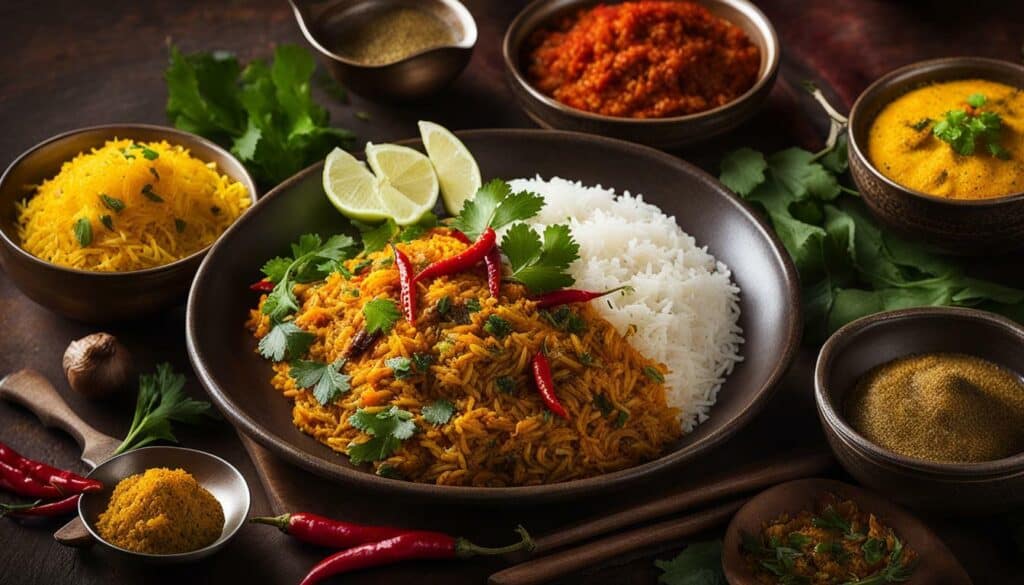
| Key Ingredients | Flavor Profile | Popular Dishes |
|---|---|---|
| Cardamom | Aromatic, sweet, and slightly spicy | Chai tea, biryanis |
| Turmeric | Earthy and slightly bitter | Curries, rice dishes |
| Garam masala | Warming, complex, and spicy | Butter chicken, tikka masala |
| Cumin | Earthy, nutty, and warm | Dal, samosas |
| Coriander | Refreshing, citrusy, and slightly sweet | Chutneys, curries |
“Indian cuisine is a symphony of flavors, a dance of spices that awaken your taste buds and transport you to a different world. From the sizzle of a tandoori oven to the fragrance of freshly ground spices, every bite is an adventure. So, come join me on this culinary journey through the rich flavors of Indian cuisine.”
Next up: A Journey Through Southeast Asia
After immersing ourselves in the vibrant flavors of Indian cuisine, our culinary adventure continues as we explore the diverse and tantalizing dishes from Southeast Asia. Get ready to discover the bold and aromatic flavors of Thailand, the delicate balance of flavors in Vietnamese cuisine, and the fiery heat of Indonesian dishes. Stay tuned for an exploration of the culinary traditions that make Southeast Asia a true food lover’s paradise.
A Journey Through Southeast Asia
Embark on a culinary journey through Southeast Asia as we discover the vibrant and mouthwatering dishes that make this region a food lover’s paradise. From the fragrant curries of Thailand to the sizzling street food of Vietnam, the flavors of Southeast Asian cuisine are as diverse as the countries themselves.
In Thailand, indulge in the bold and spicy flavors of dishes like Tom Yum Soup, Pad Thai, and Green Curry. Each bite is a symphony of flavors, combining the heat of chili peppers with the freshness of herbs like lemongrass and basil. The Thai people believe in the balance of flavors – sweet, sour, salty, and spicy – creating a harmonious taste sensation that will leave you craving for more.
In Vietnam, street food is king. Wander through the bustling markets and you’ll find an array of delicious treats like Banh Mi, Pho, and fresh spring rolls. The Vietnamese cuisine is characterized by its simplicity and freshness, with an emphasis on herbs, vegetables, and light flavors. Each dish is a delicate balance of textures and flavors, creating a culinary experience that is both comforting and refreshing.
Indonesia is a melting pot of flavors, with dishes influenced by Chinese, Indian, and Dutch cuisines. From the fragrant rice dishes of Nasi Goreng and Mie Goreng to the fiery satay skewers, Indonesian cuisine is a feast for the senses. The use of aromatic spices like turmeric, ginger, and lemongrass adds complexity and depth to the flavors, creating dishes that are rich and satisfying.
| Country | Signature Dish |
|---|---|
| Thailand | Tom Yum Soup |
| Vietnam | Pho |
| Indonesia | Nasi Goreng |
Embarking on a culinary adventure through Southeast Asia will open your taste buds to a world of exotic flavors, vibrant colors, and aromatic spices. Whether you’re a fan of spicy curries, fresh seafood, or comforting noodles, there’s something for everyone in this diverse and exciting cuisine.

So, join me as we explore the delights of Asian cooking and unlock the secrets of Southeast Asian cuisine. Get ready to tantalize your taste buds and elevate your cooking skills with the bold and vibrant flavors of this incredible region.
Exploring Chinese Culinary Heritage
China’s culinary traditions are vast and diverse, with a history that dates back thousands of years and a range of flavors that caters to every palate. From the fiery and bold flavors of Sichuan cuisine to the delicate and complex flavors of Cantonese dishes, Chinese cuisine offers a tantalizing array of tastes and textures. Join me on a journey through the flavors of China as we explore its rich culinary heritage.
One of the defining features of Chinese cuisine is its emphasis on balance. Traditional Chinese dishes strive to achieve harmony between flavors, textures, and colors. This is evident in popular dishes such as Kung Pao Chicken, which combines tender chicken, crunchy peanuts, and a balance of sweet, sour, and spicy flavors.
In Chinese cooking, spices play a crucial role in enhancing the flavors of the dish. From the floral aroma of Sichuan peppercorns to the earthy notes of star anise, each spice brings its unique character to the dish. Chinese spices are often used in combination to create complex and layered flavors, such as in the famous five-spice powder.
| Chinese Spices | Flavor Profile |
|---|---|
| Sichuan Peppercorns | Floral and numbing |
| Star Anise | Earthy and sweet |
| Cinnamon | Warm and aromatic |
| Cloves | Sweet and pungent |
| Fennel Seeds | Earthy and licorice-like |
Chinese cuisine is also known for its diverse cooking techniques, which range from stir-frying and steaming to braising and deep-frying. These techniques not only bring out the flavors of the ingredients but also contribute to the overall texture of the dish. For example, stir-frying in a hot wok imparts a smoky flavor and a delightful crispness to vegetables and meats.
The Art of Dim Sum
A notable aspect of Chinese cuisine is the art of dim sum, a traditional style of Chinese cuisine that features bite-sized portions of food served in small steamer baskets or on small plates. Dim sum is often enjoyed during breakfast or brunch and offers a wide variety of dumplings, buns, and other delicacies.
Whether you’re a fan of spicy Sichuan dishes, crave the delicate flavors of Cantonese cuisine, or want to experience the art of dim sum, Chinese culinary heritage has something to offer for every palate. Join me in the next section as we continue our exploration of Asian cooking with a focus on the precision and elegance of Japanese cuisine.
The Art of Japanese Cuisine
Immerse yourself in the art of Japanese cuisine, where every dish is a masterpiece created with exquisite precision and attention to detail. Japanese cuisine is renowned for its delicate flavors, beautiful presentation, and emphasis on fresh, high-quality ingredients. From sushi to ramen, each dish tells a story and reflects the rich culinary heritage of Japan.
One of the key elements of Japanese cuisine is the concept of umami, the fifth taste that adds depth and richness to dishes. Umami is often achieved through the use of ingredients such as miso, soy sauce, and bonito flakes, which enhance the natural flavors of the food. The balance of flavors is also crucial in Japanese cooking, with dishes typically combining sweet, sour, salty, and bitter elements to create a harmonious taste experience.
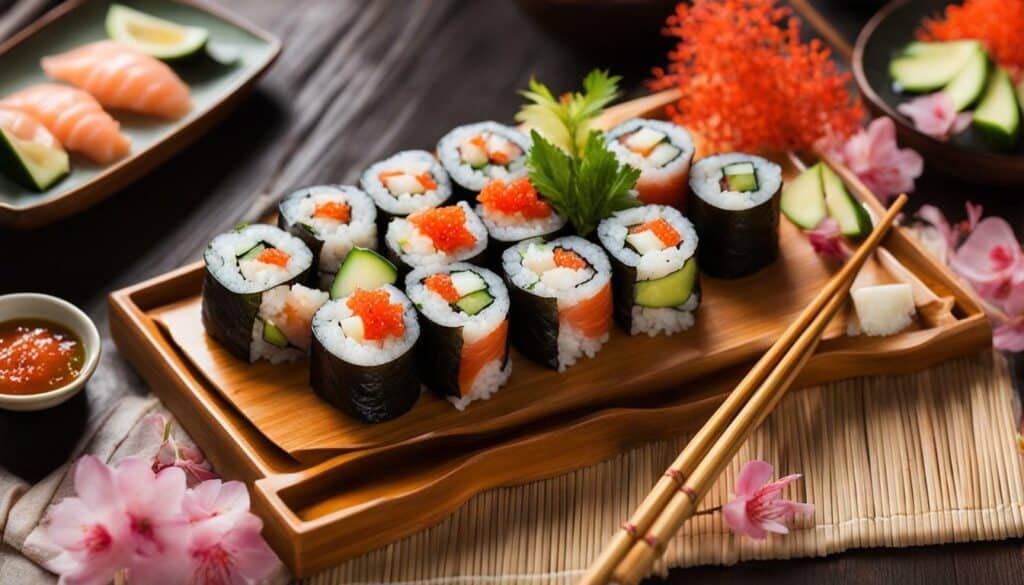
Japanese cuisine is not only a feast for the palate but also for the eyes. Presentation is of utmost importance, and each dish is meticulously arranged to create a visually stunning masterpiece. From the vibrant colors of sushi rolls to the intricate designs carved into radishes, every detail is carefully considered to create an aesthetically pleasing dining experience.
When it comes to cooking techniques, Japanese cuisine offers a wide range of methods that highlight the natural flavors of the ingredients. From the precise art of sushi-making to the delicate art of tempura frying, each technique requires skill, practice, and a deep understanding of the ingredients being used. Japanese chefs are known for their dedication to their craft, spending years honing their skills to create culinary masterpieces.
The Fusion of East and West in Asian Fusion Cuisine
Experience the best of both worlds with Asian fusion cuisine, where the flavors and techniques of the East meet the creativity and ingenuity of the West. This culinary trend is all about blending traditional Asian ingredients and cooking methods with western influences to create innovative and mouthwatering dishes that tantalize the taste buds.
Asian fusion cuisine offers a delightful combination of familiar and exotic flavors, resulting in unique taste experiences. Imagine savoring the smoky aroma of a teriyaki-glazed burger, the tangy sweetness of a Korean BBQ taco, or the delicate fusion of sushi and burrito in a tasty sushi burrito. The possibilities are endless!
One of the defining characteristics of Asian fusion cuisine is the incorporation of diverse ingredients and culinary techniques. It’s not uncommon to find dishes that combine elements from different Asian cuisines, such as Chinese, Japanese, Thai, and Korean, with western ingredients like cheeses, creams, and sauces. This fusion creates a harmonious balance of flavors, textures, and colors that truly elevate the dining experience.
| Dish | Description |
|---|---|
| Sushi Pizza | A unique blend of Japanese sushi and Italian pizza, with a crispy rice crust topped with a variety of fresh fish, vegetables, and savory sauces. |
| Korean BBQ Tacos | Tender marinated beef or pork, grilled to perfection and served in a soft tortilla with crunchy slaw, kimchi, and a drizzle of spicy mayo. |
| Peking Duck Tacos | A delicious fusion of Chinese roast duck and Mexican tacos, filled with succulent Peking duck, hoisin sauce, cucumber, and scallions. |
Asian fusion cuisine not only showcases the culinary creativity of chefs but also reflects the cultural diversity and global influences that shape our modern food landscape. It’s a celebration of flavors, a fusion of traditions, and a testament to the open-mindedness and adventurous spirit of food lovers everywhere.
So, whether you’re craving a twist on classic dishes or eager to explore new culinary horizons, Asian fusion cuisine is sure to satisfy your taste buds and ignite your imagination. Let your palate embark on a journey where East meets West, and indulge in the delightful fusion of flavors that Asian cuisine has to offer.
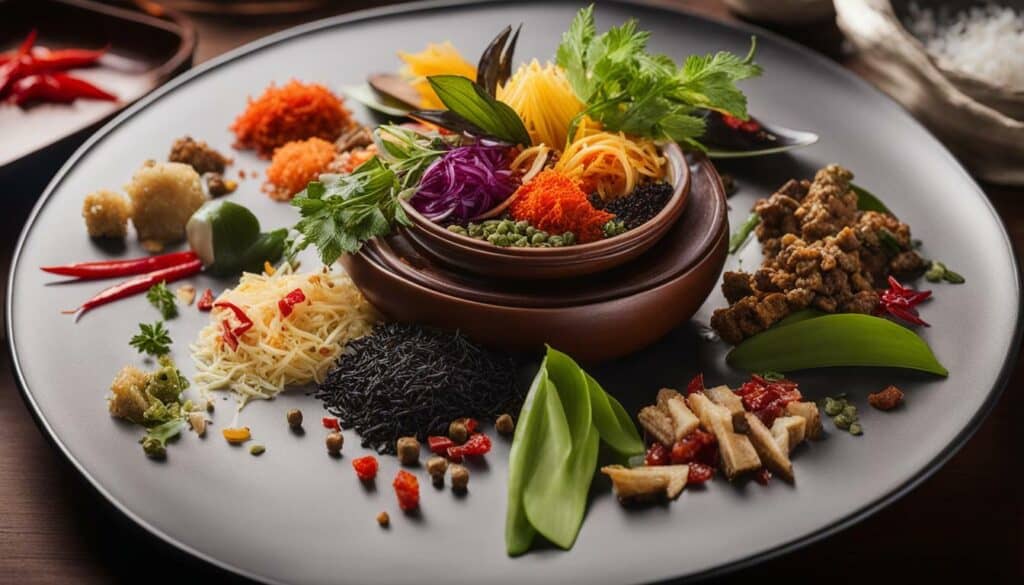
Discover the secret behind the tantalizing flavors of Asian cuisine through the essential spices and herbs that bring dishes to life. From aromatic herbs to fiery chilies and fragrant spices, Asian cooking is known for its bold and complex flavors. Whether you’re a novice cook or an experienced chef, understanding these key ingredients will elevate your dishes to new heights.
Let’s start with one of the most iconic Asian spices – ginger. With its warm and zesty flavor, ginger adds a unique kick to both savory and sweet dishes. It pairs well with seafood, stir-fries, and even desserts like gingerbread. Another staple in Asian cooking is garlic, known for its pungent aroma and robust taste. It forms the base of many sauces, marinades, and stir-fries, lending depth and complexity to the final dish.
No discussion of Asian spices would be complete without mentioning chilies. From mild to fiery hot, chilies add heat and a touch of excitement to Asian dishes. Whether used fresh, dried, or in the form of chili paste or sauce, they can be found in a variety of cuisines, such as Thai, Indian, and Korean.
| Spice/Herb | Flavor Profile | Common Use |
|---|---|---|
| Ginger | Warm, zesty | Stir-fries, seafood, desserts |
| Garlic | Pungent, robust | Sauces, marinades, stir-fries |
| Chilies | Varies from mild to hot | Thai, Indian, Korean cuisine |
“The use of spices and herbs in Asian cooking is essential in creating the bold and distinctive flavors that we all love. They add depth, complexity, and a touch of excitement to every dish.” – Chef Mei Lin
Asian cuisine also relies heavily on lemongrass and kaffir lime leaves for their citrusy and refreshing notes. Lemongrass, often used in soups, curries, and marinades, imparts a lemony flavor with hints of ginger. On the other hand, kaffir lime leaves add a distinctive aroma to Thai and Southeast Asian dishes, such as curries, stir-fries, and salads.
These are just a few examples of the essential spices and herbs used in Asian cooking. By mastering the art of incorporating these flavors into your dishes, you’ll be able to create authentic Asian cuisine that delights the senses. So, let’s embark on this culinary adventure together and unlock the secrets of Asian spices and herbs.
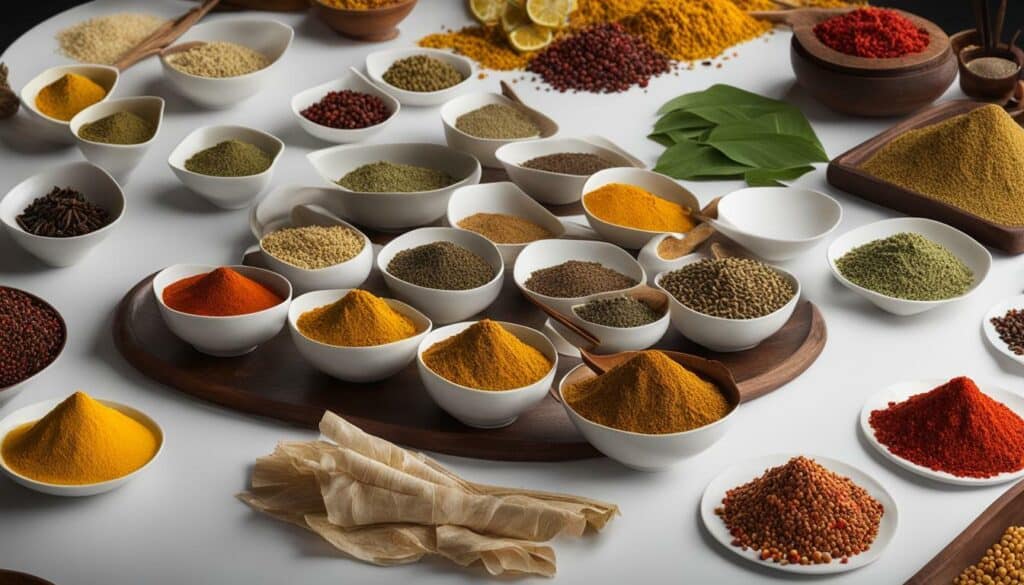
- Turmeric: Known for its vibrant yellow color and earthy flavor, turmeric is a staple in Indian and Southeast Asian cuisines. It is often used in curries, rice dishes, and marinades.
- Coriander: Both the seeds and leaves of the coriander plant are used in Asian cooking. The seeds have a warm, citrusy flavor, while the leaves (cilantro) add freshness to dishes like salads, salsas, and curries.
- Thai Basil: With its distinct licorice-like flavor, Thai basil is a key ingredient in Thai and Vietnamese cuisines. It is commonly used in stir-fries, curries, and soups.
- Star Anise: This star-shaped spice adds a sweet and licorice-like flavor to Chinese and Vietnamese dishes. It is often used in braised meats, soups, and marinades.
By embracing the unique flavors of Asian spices and herbs, you’ll be able to take your taste buds on a journey through the vibrant and diverse world of Asian cuisine. So, get ready to infuse your dishes with authentic Asian flavors and elevate your culinary creations to new heights.
Regional Specialties: Exploring Asian Culinary Diversity
Journey through Asia’s culinary landscape, where each region offers a distinct array of flavors, ingredients, and cooking styles that reflect their cultural heritage. From the aromatic curries of India to the delicate sushi of Japan, the diversity of Asian cuisine is truly remarkable. Let’s embark on a gastronomic adventure as we explore the regional specialties that define the unique flavors of Asia.
India: Spices and Bold Flavors
The cuisine of India is a celebration of spices, with each dish bursting with a myriad of flavors. From the fiery heat of chili peppers to the aromatic notes of coriander and cumin, Indian cuisine tantalizes the taste buds and awakens the senses. Regional specialties like the buttery naan bread of North India, the tangy tamarind-infused chutneys of South India, and the rich Mughlai curries of Lucknow showcase the diverse culinary traditions of this vast country.
Thailand: Sweet, Sour, Salty, and Spicy
Known for its harmonious blend of flavors, Thai cuisine offers a balance of sweet, sour, salty, and spicy elements in every mouthful. From the fragrant green curry to the tangy som tam (papaya salad), each dish is a symphony of flavors that dance on the palate. Regional specialties such as the spicy tom yum soup of Central Thailand, the creamy massaman curry of Southern Thailand, and the vibrant pad Thai noodles of Bangkok showcase the diverse culinary traditions of this tropical paradise.
China: Dim Sum and Noodles
China’s culinary heritage is rich and varied, with each region boasting its own specialties and cooking techniques. From the delicate dumplings of Cantonese dim sum to the fiery dan dan noodles of Sichuan cuisine, Chinese cuisine is a treasure trove of culinary delights. The crispy Peking duck of Beijing, the aromatic braised dishes of Shanghai, and the savory hot pot of Chengdu are just a few examples of the incredible diversity of flavors found in Chinese cooking.
| Country | Specialty Dish | Description |
|---|---|---|
| India | Chicken Vindaloo | A spicy curry dish with tender chicken pieces marinated in a tangy sauce made of vinegar, garlic, and a blend of aromatic spices. |
| Thailand | Pad Thai | A classic Thai stir-fried noodle dish made with rice noodles, shrimp, tofu, bean sprouts, and flavored with tamarind, fish sauce, and lime. |
| China | Kung Pao Chicken | A flavorful stir-fry dish featuring tender chicken, peanuts, and vegetables, tossed in a spicy and tangy sauce. |
Asian cuisine is a tapestry of flavors, ingredients, and cooking techniques, with each region offering its own unique culinary treasures. From the fragrant spices of India to the delicate balance of flavors in Thai cuisine, exploring the regional specialties of Asian cooking is like embarking on a mouthwatering journey. So, grab your chopsticks and get ready to savor the vibrant and diverse flavors of Asia.
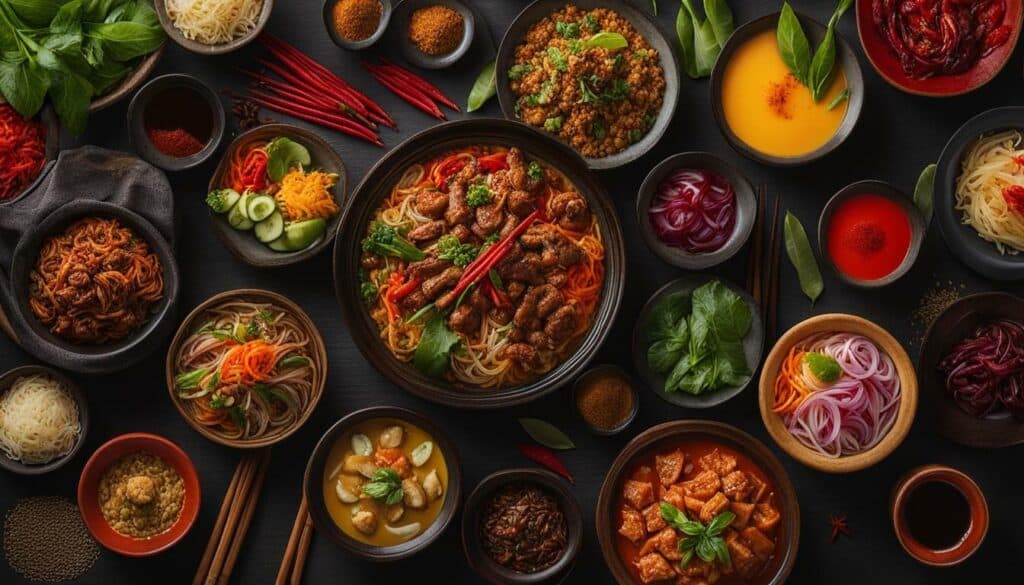
Unlock the mysteries of Asian cooking techniques as we explore the art of stir-frying, steaming, grilling, and more. Asian cuisine is renowned for its precision and attention to detail, and these cooking techniques play a pivotal role in creating delicious and authentic dishes.
Stir-frying is a cornerstone of Asian cooking, allowing for quick and flavorful meals. The high heat and fast cooking time result in beautifully caramelized ingredients while retaining their natural crunchiness. Whether it’s a classic Chinese stir-fry or a spicy Thai pad Thai, mastering the technique of stir-frying will elevate your culinary repertoire.
Next, we have steaming, a traditional cooking method used across Asia to preserve the natural flavors and textures of ingredients. Steaming not only enhances the taste of delicate seafood, such as steamed fish with ginger and soy sauce, but also retains the nutrients, making it a healthier and lighter option for those seeking a balanced diet.
Last but not least, grilling is another popular technique in Asian cuisine, adding a delightful smoky flavor to meats, seafood, and even vegetables. From Japanese yakitori to Malaysian satay, grilling unlocks a myriad of flavors and textures that are sure to impress your taste buds.
| Asian Cooking Techniques | Description |
|---|---|
| Stir-frying | A quick and high-heat cooking technique that results in caramelized ingredients and vibrant flavors. |
| Steaming | A gentle cooking method that preserves the natural flavors and nutrients of ingredients, perfect for seafood and vegetables. |
| Grilling | Adds a smoky flavor to meats, seafood, and vegetables, enhancing their taste and texture. |
With these essential Asian cooking techniques in your culinary arsenal, you’ll be able to recreate the authentic flavors of Asia in your own kitchen. So, embrace the art of stir-frying, steaming, grilling, and more, and let your taste buds embark on a journey filled with exquisite flavors and tantalizing textures.
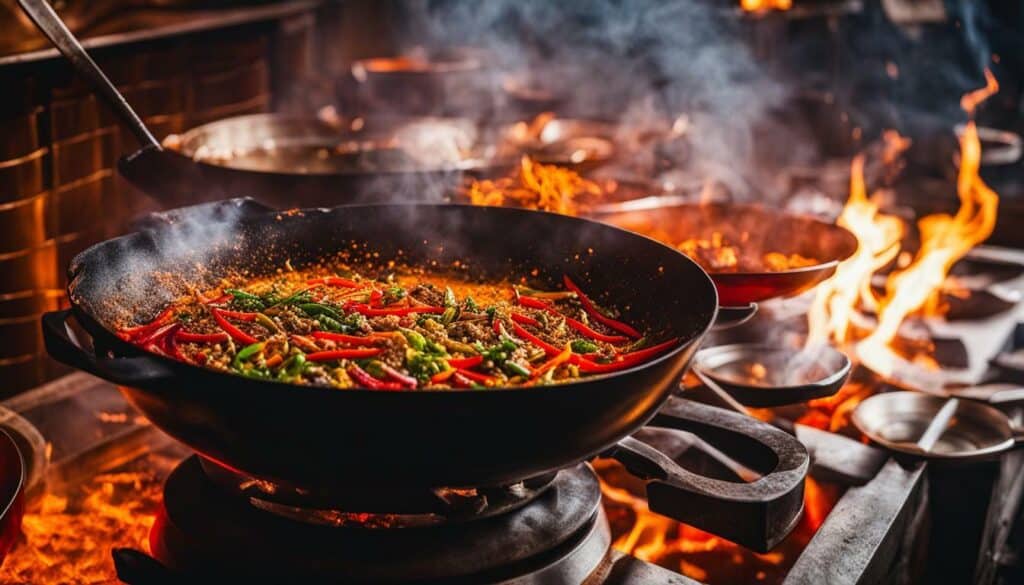
Experience the wonders of Asian cooking and master these techniques to create a culinary masterpiece with every dish. Join me on this exciting adventure as we continue our exploration of Asian cuisine.
Adding Asian Flair to Your Culinary Repertoire
Elevate your cooking skills and bring the flavors of Asia into your kitchen with these simple tips and tricks. Asian cuisine is known for its bold and vibrant flavors, and by incorporating a few key ingredients and techniques, you can create delicious Asian-inspired dishes that will impress your family and friends.
One of the easiest ways to add Asian flair to your cooking is to experiment with Asian spices. From the warmth of ginger to the heat of chili peppers, Asian spices can transform ordinary dishes into extraordinary culinary creations. Stock up your pantry with essentials like soy sauce, fish sauce, sesame oil, and rice vinegar, and get ready to infuse your dishes with authentic Asian flavors.
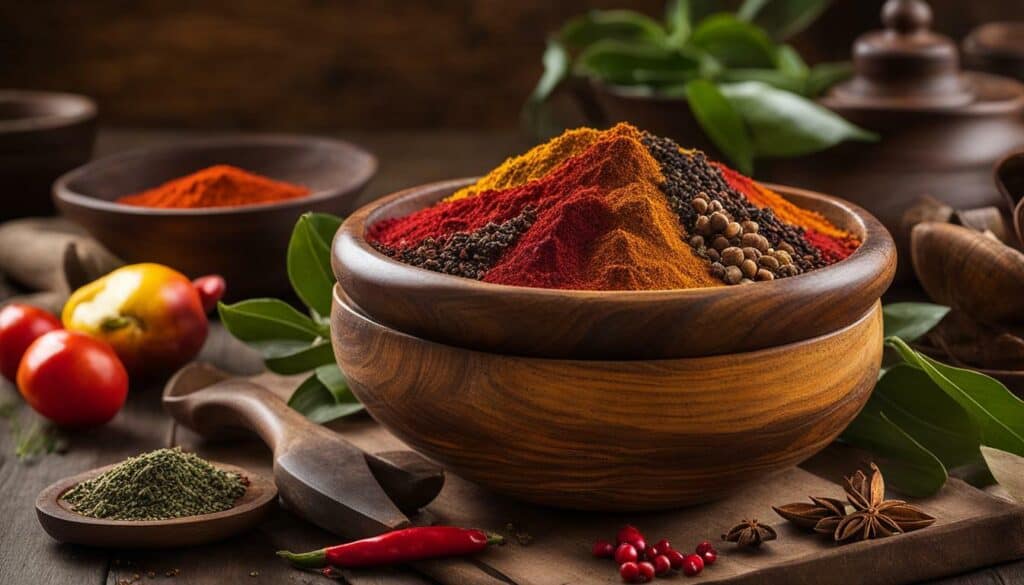
To create authentic Asian dishes, it’s important to pay attention to cooking techniques. Stir-frying is a popular method in Asian cuisine, allowing ingredients to retain their color, texture, and flavor. Invest in a wok or large non-stick skillet, and master the art of quick and high-heat cooking. Whether you’re stir-frying vegetables, meats, or noodles, a few minutes in a hot wok can result in a delicious and healthy meal.
Asian Cooking Techniques
Another technique that adds depth and complexity to Asian dishes is steaming. Steaming not only preserves the nutritional value of ingredients but also imparts a delicate and moist texture. Invest in a steamer basket or bamboo steamer, and try steaming fish, dumplings, or vegetables for a healthy and flavorful meal.
To fully embrace the flavors of Asia, remember the importance of balance. Asian cuisine often combines sweet, sour, salty, and spicy flavors in perfect harmony. Experiment with these flavor profiles and find the right balance for your taste. Whether it’s adding a splash of lime juice to balance the sweetness of a dish or a sprinkle of chili flakes for a touch of heat, play around with ingredients to create a symphony of flavors in your own kitchen.
| Asian Spice | Flavor Profile | Common Uses |
|---|---|---|
| Ginger | Earthy, spicy, slightly sweet | Stir-fries, marinades, soups |
| Garlic | Pungent, savory | Sauces, marinades, stir-fries |
| Soy Sauce | Salty, savory, umami | Marinades, stir-fries, dipping sauces |
| Sesame Oil | Nutty, aromatic | Dressings, marinades, stir-fries |
| Chili Pepper | Hot, spicy | Curries, stir-fries, sauces |
“Asian cuisine is all about finding the perfect balance of flavors and textures. It’s a culinary journey that celebrates harmony and diversity. Don’t be afraid to experiment and make it your own!”
So, why not take a culinary adventure and explore the wonders of Asian cooking? With these simple tips and tricks, you can add a touch of Asian flair to your culinary repertoire and create delicious and memorable meals that will transport you to the vibrant streets of Asia.
Exploring the Health Benefits of Asian Cuisine
Discover how Asian cuisine not only delights the taste buds but also nourishes the body, with its focus on fresh ingredients, balanced flavors, and mindful cooking practices. Asian food has gained worldwide popularity not only for its delicious taste but also for its health benefits. With a variety of ingredients and cooking methods, Asian cuisine offers a wholesome and nutritious dining experience.
One of the key factors that contribute to the health benefits of Asian food is the emphasis on fresh ingredients. From vibrant vegetables to succulent seafood, Asian dishes are often made with locally sourced and seasonal produce. This ensures that the ingredients are at their peak freshness, allowing for maximum flavor and nutritional value. By incorporating a wide range of colorful fruits and vegetables, Asian cuisine provides a rich array of vitamins, minerals, and antioxidants that support overall health and wellbeing.
In addition to fresh ingredients, Asian cuisine is known for its balanced flavors. The combination of sweet, sour, salty, and spicy creates a harmonious taste profile that not only pleases the palate but also has health benefits. For example, the use of ginger, garlic, and turmeric in many Asian dishes provides anti-inflammatory properties, helping to boost the immune system and reduce the risk of chronic diseases. Furthermore, the mindful use of spices and herbs in Asian cooking adds depth and complexity to the flavors without relying heavily on unhealthy fats and oils.
Mindful cooking practices are also an integral part of Asian cuisine. Steaming, stir-frying, and boiling are commonly used methods that preserve the nutritional content of the ingredients. These cooking techniques require minimal use of oil, resulting in lighter and healthier dishes. By keeping the cooking time short, Asian cuisine retains the natural flavors and textures of the ingredients, ensuring that the nutrients are not lost in the cooking process.

| Key Health Benefits of Asian Cuisine: |
|---|
| • Rich in fresh fruits and vegetables, providing essential nutrients and antioxidants. |
| • Balanced flavors that promote a well-rounded taste profile and offer potential health benefits. |
| • Mindful cooking techniques that preserve the nutritional content of the ingredients. |
| • Incorporation of a variety of herbs and spices with potential anti-inflammatory properties. |
In conclusion, Asian cuisine not only offers a delightful culinary experience but also provides numerous health benefits. By focusing on fresh ingredients, balanced flavors, and mindful cooking practices, Asian food nourishes both the body and the soul. Embrace the flavors of Asia and discover a world of delicious and nutritious dishes that will elevate your cooking skills and support your overall wellbeing.
Conclusion
As we reach the end of our culinary adventure, I hope this exploration of Asian cooking has inspired you to embark on your own flavorful journey, discovering the diverse and delectable world of Asian cuisine. From the rich flavors of Indian cuisine to the delicate artistry of Japanese cooking, Asian food offers a tantalizing array of tastes and techniques to satisfy every palate.
Throughout our journey, we’ve explored the essential spices and herbs that give Asian dishes their unique depth of flavor. We’ve uncovered the regional specialties and culinary diversity found across Asia, showcasing the wide range of dishes and cooking techniques from different countries and cultures.
But our exploration doesn’t have to end here. Armed with the knowledge and inspiration gained from this culinary adventure, you can now add a touch of Asian flair to your own cooking. Experiment with the fusion of East and West, master essential Asian cooking techniques, and reap the health benefits of fresh ingredients and mindful cooking practices.
So, whether you’re a seasoned cook looking to expand your repertoire or a beginner eager to discover new flavors, Asian cuisine is sure to delight and inspire. Grab your apron, gather your ingredients, and let the captivating world of Asian cooking take you on a gastronomic journey you’ll never forget.
FAQ
Q: What is Asian cooking?
A: Asian cooking refers to the culinary traditions and practices found in various countries across Asia, including China, Japan, India, Thailand, and more. It encompasses a wide range of flavors, ingredients, and cooking techniques that make Asian cuisine unique and diverse.
Q: What are some popular Asian dishes?
A: Popular Asian dishes include sushi and sashimi from Japan, Pad Thai from Thailand, General Tso’s Chicken from China, Chicken Tikka Masala from India, and Pho from Vietnam. These dishes showcase the rich flavors and unique ingredients found in Asian cooking.
Q: How can I incorporate Asian flavors into my cooking?
A: To incorporate Asian flavors into your cooking, you can start by using essential Asian spices and herbs such as ginger, garlic, soy sauce, and sesame oil. You can also experiment with Asian cooking techniques like stir-frying, steaming, and grilling. Exploring Asian recipes and trying out different ingredients will help you add Asian flair to your culinary repertoire.
Q: Is Asian cooking healthy?
A: Asian cooking often focuses on fresh ingredients, balanced flavors, and mindful cooking practices, which can contribute to a nutritious and wholesome dining experience. However, it’s important to note that the healthiness of Asian dishes can vary depending on the specific ingredients and cooking methods used.
Q: What are some popular Asian spices and herbs?
A: Popular Asian spices and herbs include ginger, garlic, turmeric, chili peppers, lemongrass, coriander, and star anise. These ingredients add unique flavors and aromas to Asian dishes and are often used in various combinations to create complex and delicious flavors.
Q: Are there vegetarian options in Asian cuisine?
A: Yes, Asian cuisine offers a wide variety of vegetarian options. Many traditional Asian dishes feature vegetables, tofu, and plant-based proteins as the main ingredients. Some popular vegetarian Asian dishes include vegetable stir-fries, tofu curries, vegetable dumplings, and vegetarian sushi rolls.
Q: How can I learn more about authentic Asian cooking?
A: You can learn more about authentic Asian cooking by exploring cookbooks, attending cooking classes or workshops, and experimenting with different recipes at home. Online resources and food blogs can also provide valuable information and inspiration for exploring the diverse flavors and techniques of Asian cuisine.
Q: What are some common cooking techniques used in Asian cuisine?
A: Common cooking techniques used in Asian cuisine include stir-frying, steaming, braising, deep-frying, and grilling. Each technique brings out different flavors and textures in the ingredients, allowing for a wide range of dishes to be created.
Q: Can I make Asian fusion dishes at home?
A: Absolutely! Asian fusion cuisine combines traditional Asian flavors with Western culinary techniques, resulting in innovative and delicious dishes. You can experiment with blending different cultural influences and ingredients to create your own Asian fusion recipes at home.
Q: How can I make my Asian dishes more authentic?
A: To make your Asian dishes more authentic, it’s important to use the right ingredients and follow traditional cooking techniques. Using authentic Asian spices, herbs, and sauces will enhance the flavors of your dishes. Additionally, studying regional specialties and understanding the cultural context behind the recipes will help you achieve an authentic Asian culinary experience.
Can the App Help Me Find Asian Recipes Based on Ingredients I Have?
Sure, an app for cooking with ingredients can definitely help you find Asian recipes based on the ingredients you have. By simply entering the ingredients you have on hand, the app can suggest various Asian recipes that you can prepare with those ingredients. This eliminates the hassle of searching for recipes manually and allows you to explore exciting Asian cuisine effortlessly.

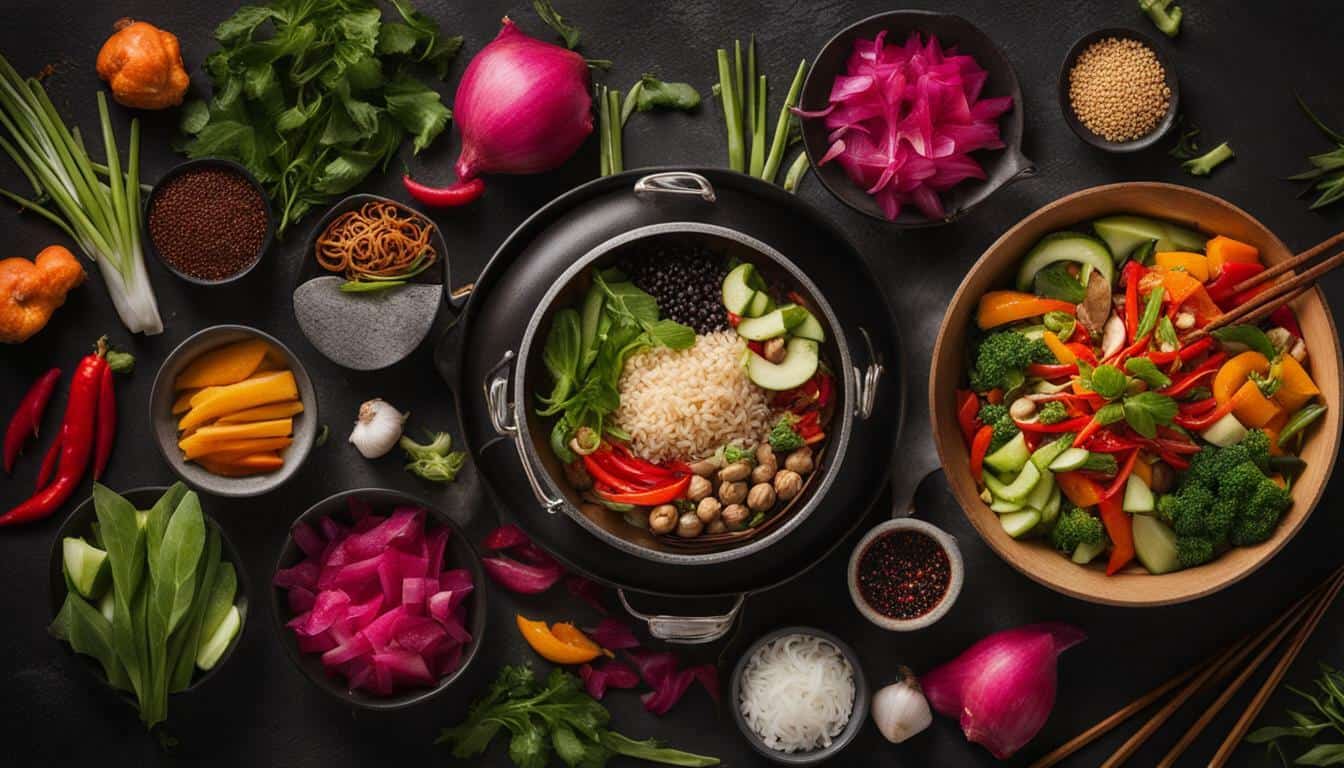
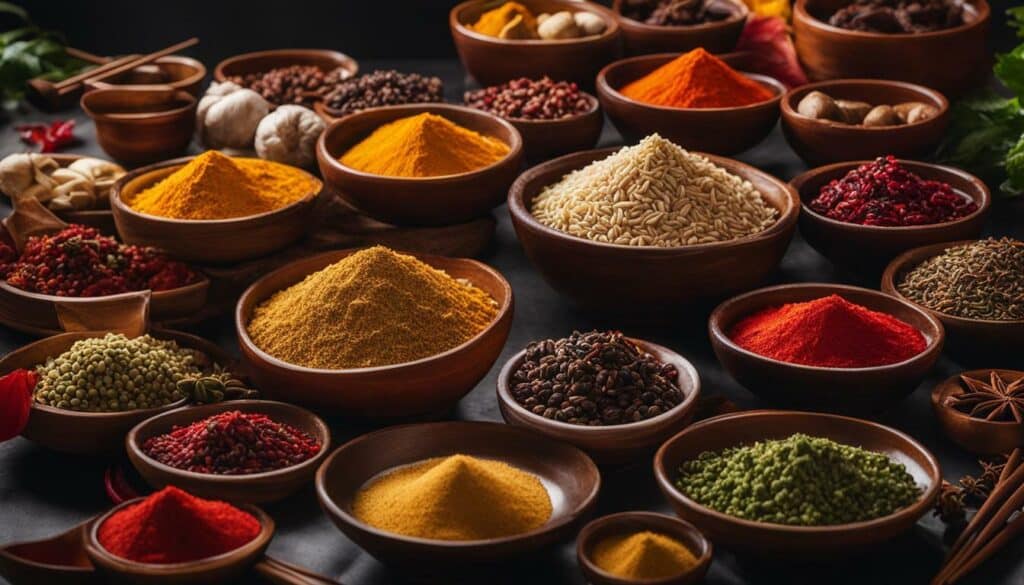



Leave a Reply